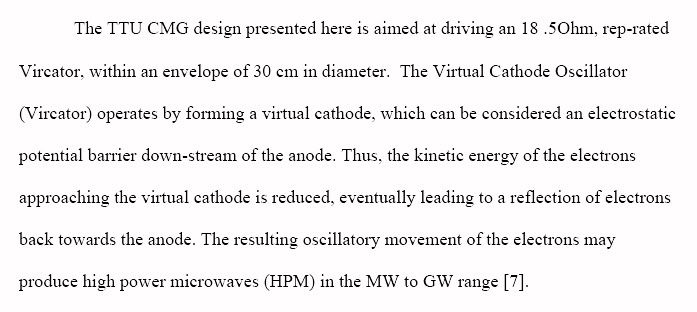Page 1 of 1
Vircators - (VIRtual CAthode OscillatOR) circa 1980
Posted: Wed Feb 13, 2008 2:33 pm
by Keegan
We have been studying Plasmas for about 100 years now. After reading the POPS papers, it is easy to assume that we just recently married RF and Periodically Oscillating Plasma Spheres together. This is not the case.
Presenting the
Vircator
"The present invention relates broadly to microwave generators, and in particular to a high power microwave generator apparatus
utilizing a relativistic electron beam to generate microwave energy as a consequence of induced virtual cathode oscillation."
* First patented in 1982
* Widely Tunable Frequency. (Tied to E & B field drive)
* GW powers (Pulsed)
* High efficiency (30-40%)
* TM Mode
So as usual they got things backwards. Instead of driving virtual cathodes with RF, they are driving RF with virtual cathodes.
The following vircator papers appear to be an excellent starting point for POPS / Virtual Cathode Physics
U.S. Patent 4,345,220 (1982)
High Power Microwave Generation From a Vircator (1983)
U.S. Patent 4,730,170 (1988)
One interesting thing to note is that the last patent was awarded to
"Thomas J. T. Kwan, Charles M. Snell both from Los Alamos, New Mexico." Could this be where the POPS guys got their ideas ?
-k
Posted: Wed Feb 13, 2008 2:44 pm
by Keegan
Patent 4345220 wrote: It is another object of the invention to provide an improved microwave generator apparatus
capable of generating high power microwaves in the order of 10^10 to 10^12 watts

Dear God .....
Posted: Wed Feb 13, 2008 2:48 pm
by drmike
If nothing else just being around the people who built the original ones might have given them ideas. That's the whole point of a scientific lab, so let's hope so!
Very nice find too, thanks!
(Edit: it is a weapons lab you know!!)
Posted: Thu Feb 14, 2008 6:05 am
by scareduck
Missing where the ions fit into this device, i.e. how does plasma fit into the Vircator device. It looks to me like just another mechanism for generating microwaves, albeit some pretty serious ones.
It sort of looks like a cavity resonator, if I understand the physics correctly, except that the resonance of the cavity is tunable according to the size of the virtual electrode.
Posted: Thu Feb 14, 2008 9:21 am
by Keegan
scareduck wrote:Missing where the ions fit into this device,
Well they dont.

It sort of looks like a cavity resonator, if I understand the physics correctly,
The cavity is there just to confine the electron beam and alow a virtual cathode to form. The virtual cathode forms, oscillates and generates RF according to plasma frequency.

So essentially there are two basic types of Periodically Oscillating Plasma Spheres (POPS). Virtual Cathodes and Virtual Anodes. The patents presented here are dealing just with virtual cathodes.
This is a very good as it once again validates the current work being done with POPS virtual anodes at LANL. If an electron is 1 / 1836 the mass of a proton then one would expect the frequency of a virtual cathode to roughly be 1836 times the frequency of a virtual anode. Which appears to be the case.
Posted: Thu Feb 14, 2008 2:04 pm
by MSimon
Keegan,
It is an electron resonance and is dependent on density.
POPS is independent of density. Particle mass, charge, potential well, and size of reactor control POPS.
Posted: Thu Feb 14, 2008 4:51 pm
by scareduck
No ions = no POPS (you're missing the second P = plasma).
Posted: Mon Feb 18, 2008 2:44 am
by Keegan
Virtual Cathode Theory and Design of a Millimeter Wave Vircator.
The advantage of the vircator over a reflex klystron is that the virtual cathode moves opposite to the electron beam propagation direction during the bunching phase resulting in enhanced electron densities unobtainable otherwise. The periodic time-dependent nature of the bunching results in efficient microwave generation. (rrh)
Interesting.
Posted: Mon Feb 18, 2008 3:46 am
by Keegan
Found this great paper on
how to drive a virtual cathode. A source that matches the resonant frequency can drive it. Provided it is the correct distance away as energy is reflected back from the virtual cathode into the electron beam. This can cause distructive interference if one is not carefull.
We have simulated the operation of a vircator
klystron provided with an external feedback. It was
found that the oscillator allows one to efficiently handle
the formation of structures in the electron stream. If the
input resonator is tuned to the natural frequency of the
VC, three oscillation conditions are possible, depending
on the feedback delay: (1) almost sinusoidal oscillation,
(2) weak quasi-periodicity with two base frequencies
(one of which is dominant), and (3) chaos in
the form of fully developed two-periodic oscillation
with two incommensurable frequencies. The onset of
chaos is related to the formation of secondary structures
in the electron stream as a result of its modulation,
with the feedback delay being sufficiently large.
Posted: Sun Mar 02, 2008 6:50 am
by Keegan
Hey all, i just finished reading a great Phd thesis by Yeong-Jer Chen.
Compact, repetitive Marx generator and HPM generation with the Vircator
Awesome details and construction of a portable marx generator, e field and power circuit design of a portable vircator. Also had a very interesting analysis of micro-grating (machining) the cathode surface to optimize emission.
I highly recommend you all download.
Posted: Sun Mar 02, 2008 11:07 am
by Keegan
Quoted from
^Above^

Posted: Sun Mar 02, 2008 3:32 pm
by drmike
The photoetched cathode is pretty interesting, should definitly help with field emmission.
Thanks!

